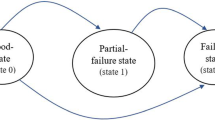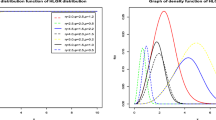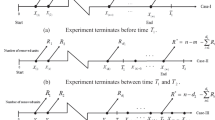Abstract
This work is motivated by modelling of real information systems. Parallel and series reliability models or their combinations are usually used for these tasks. Common assumptions for such models are independent failures, exponentially distributed failures and recoveries. These assumptions simplify a system modelling significantly, but often give a very rude approximation for it. So there are a lot of restrictions for an application of these models to practical tasks. This study presents a system with more general assumptions: dependent failures, arbitrary failures and repairs, and a system with control. We apply a continuous-time semi-Markov process to evaluate the reliability and the mean time to system failure (MTTF) for a system under these assumption. The repair time of each component is assumed to have an arbitrary distribution function (e.g., Weibull, Poisson or exponential). Kolmogorov equations method and the Laplace transform are used to derive generalised expressions for system state probabilities, reliability and MTTF. A numerical example is presented in order to illustrate the performance analysis of the model.







Similar content being viewed by others
References
Abdel-Hameed M (2012) Reliability theory and models. Academic Press, London
Alfa AS (2010) Queueing theory for telecommunications: discrete time modelling of a single node system. Springer, Berlin
Arajo C, Maciel P, Zimmermann A, Andrade E, Sousa E, Callou G, Cunha P (2011) Performability modeling of electronic funds transfer systems. Computing 91(4):315–334
Assis EM, Borges EP, Vieira de Melo SAB (2013) Generalized q-Weibull model and the bathtub curve. Int J Q Reliab Manage 30(7):720–736
Barlow R (1996) Engineering reliability. In: ASA-SIAM, series on statistics and applied pribability
Barlow R, Proschan F (1996) Mathematical theory of reliability. In: SIAM
Bazovsky I (2013) Reliability theory and practice. Courier Corporation, Chelmsford
Birolini A (2013) Reliability engineering: theory and practice. Springer Science & Business Media, Berlin
Blischke W, Prabhakar D (2000) Reliability: modeling, prediction, and optimization. Wiley, New York
Fiondella L, Xing L (2015) Discrete and continuous reliability models for systems with identically distributed correlated components. Reliab Eng Syst Saf 133:1–10
Franke U, Holm H, Konig J (2014) The distribution of time to recovery of enterprise IT service. IEEE Trans Reliab 63(4):858–867
Huang W, Loman J, Song T (2015) A reliability model of a warm standby configuration with two identical sets of units. Reliab Eng Syst Saf 133:237–245
Kalimulina EY (2011) Mathematical model for reliability optimisation of distributed telecommunications networks. In: International conference on computer science and network technology (ICCSNT), vol 4, pp 2847–2853
Kalimulina EY (2012) Analytical models for reliability estimation of distributed telecommunication networks. In: Proceedings of the 2nd international conference on computer science and network technology (ICCSNT), pp 345–348
Kalimulina EY (2013) A new approach for dependability planning of network systems. Int J Syst Assur Eng Manage 4(3):215–222
Khan AH, Jan TR (2015) Reliability evaluation of engineering system using modified Weibull distribution. Res J Math Stat Sci 3(7):1–8
Kumar A, Malik SC (2012) Reliaibility modeling of a computer system with a priority to S/W replacement over H/W replacement subjectto MOT and MRT. Int J Pure Appl Math 80(5):693–710
Kumar G, Jain V, Gandhi OP (2014) Steady-state availability analysis of repairable mechanical systems with opportunistic maintenance by using Semi–Markov process. Int J Syst Assur Eng Manage 5(4):664–678
Li X-Y, Liu Y, Chen C-J, Jiang T (2016) A copula-based reliability modelling for nonrepairable multi-state k-out-of-n systems with dependent components. Proc Inst Mech Eng Part 0 J Risk Reliab 230:133–146
Munday VJ, Malik SC (2014) Reliability measures of a computer system with different repair and redundant policies for components. Int J Stat Reliab Eng 1:26–35
Nader FM (2014) Computer and communication networks. Prentice Hall, Upper Saddle River
Norros I, Kuusela P, Lapuyade-Lahorgue J, Naldi M, Sirvio M (2014) Repairable systems with dependent components: stochastic process techniques and models. IEEE Trans Reliab 63(4):899–912
O’Connor AN (2011) Probability distributions used in reliability engineering. Reliability Information Analysis Center (RIAC), Utica, NY
Oprisan G, Limnios N (2001) Semi-Markov processes and reliability. Birkhauser, Boston
Ramakumar R (2000) Reliability engineering. CRC Press LLC, London
Rossberg AG (2008) Laplace transforms of probability distributions and their inversions are easy on logarithmic scales. J Appl Probab 45(num 2):531–541
Shooman M (2003) Reliability of computer systems and networks: fault tolerance, analysis and design. Wiley, New York
Siewiorek D, Swarz R (2014) Reliable computer systems: design and evaluation. Digital Press, Newton
Thanakornworakij T, Nassar RF, Leangsuksun C, Pun M (2012) A reliability model for cloud computing for high performance computing applications. In: Euro-Par 2012: parallel processing workshops. The series lecture notes in computer science, vol 7640, pp 474–483
Titman AC (2014) Estimating parametric semi-Markov models from panel data using phase-type approximations. Stat Comput 24(2):155–164
Ushakov IA (1994) Handbook of reliability engineering. Wiley, New York
Ushakov IA (2012) Probabilistic reliability models. Wiley, New York
Xin Q, Zhan Z, Decheng Z, Xiaozong Y (2014) Optimal maintenance policy for high reliability load-sharing computer systems with k-out-of-n: G redundant structure. Appl Math Inf Sci 8(1L):341–347
Zhou G, Guo B, Gao X, Zhao D, Yan Y (2014) Research on the system reliability modeling based on markov process and reliability block diagram. In: Proceeding of the first Euro-China conference on intelligent data analysis and applications, vol II, Shenzhen, China, pp 545–553
Acknowledgments
This study is supported by the Russian Foundation for Basic Research, Project Nos. 14-07-31245 mol-a, 15-08-08677 A.
Author information
Authors and Affiliations
Corresponding author
Rights and permissions
About this article
Cite this article
Kalimulina, E.Y. Analysis of system reliability with control, dependent failures, and arbitrary repair times. Int J Syst Assur Eng Manag 8, 180–188 (2017). https://doi.org/10.1007/s13198-016-0520-5
Received:
Revised:
Published:
Issue Date:
DOI: https://doi.org/10.1007/s13198-016-0520-5




